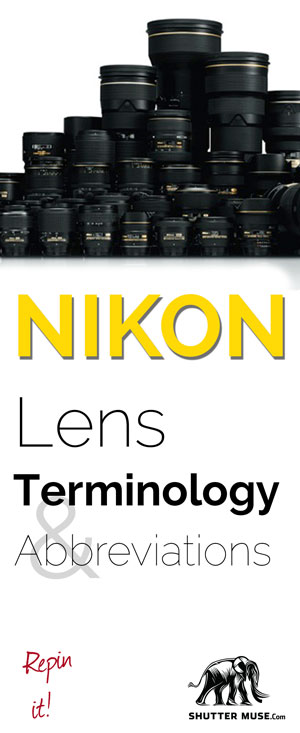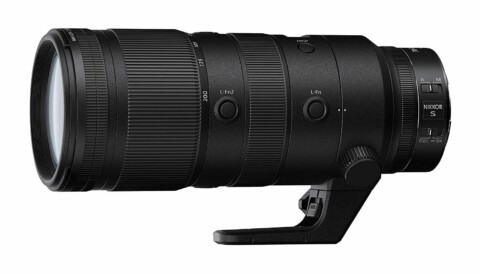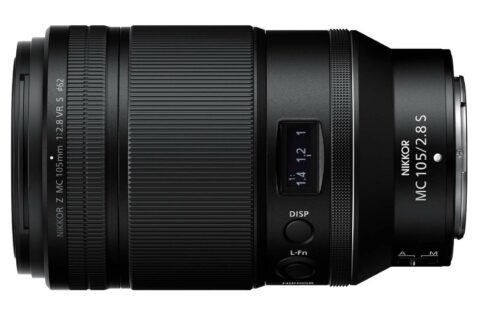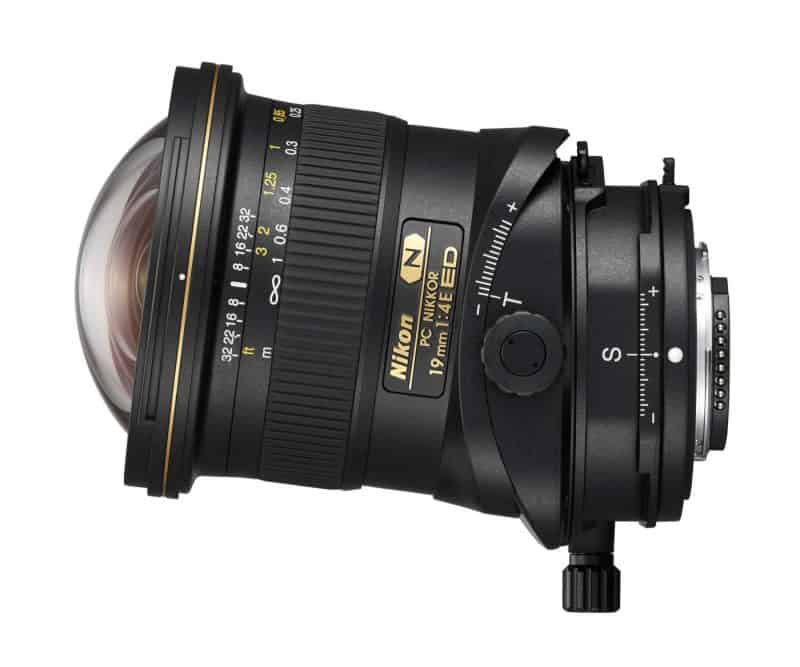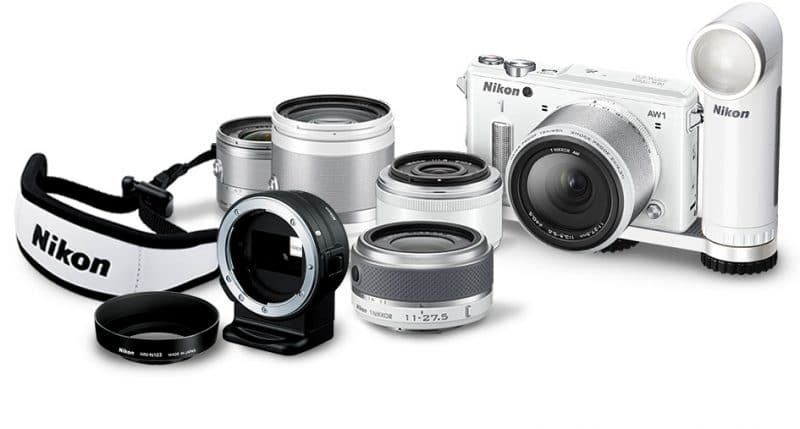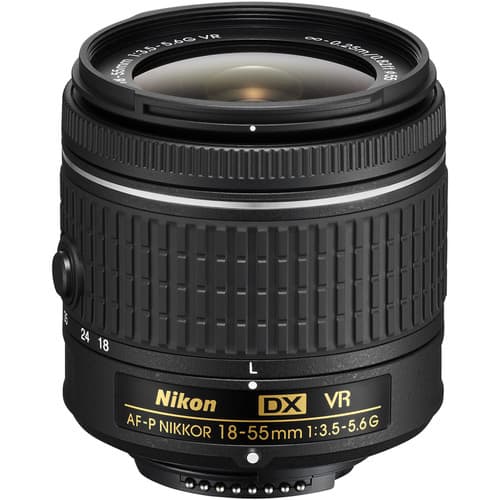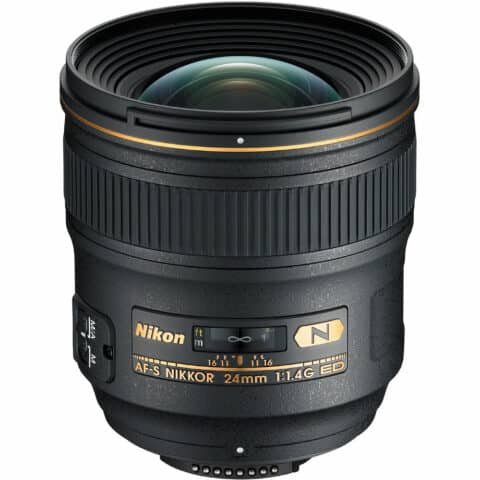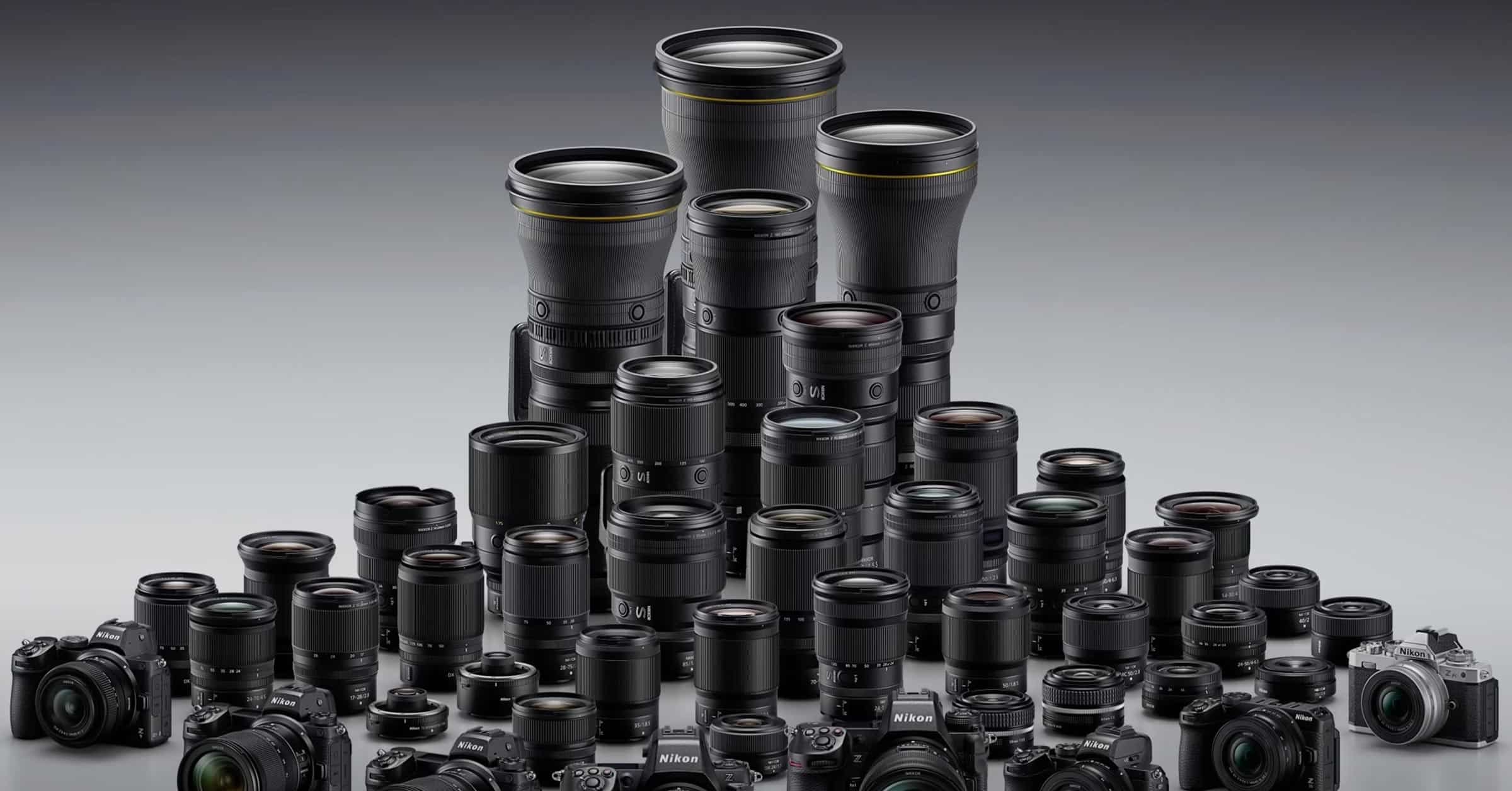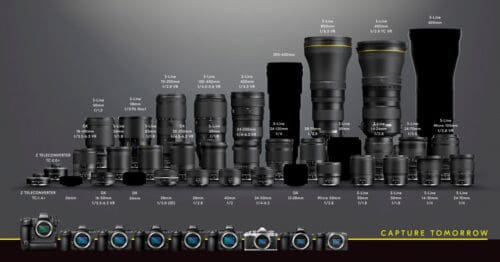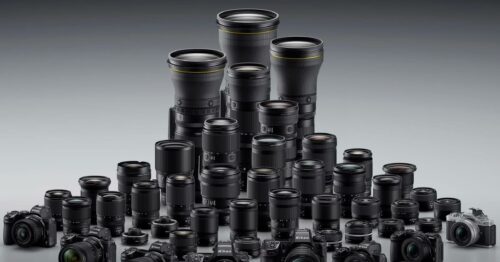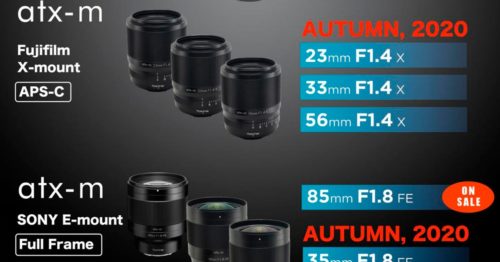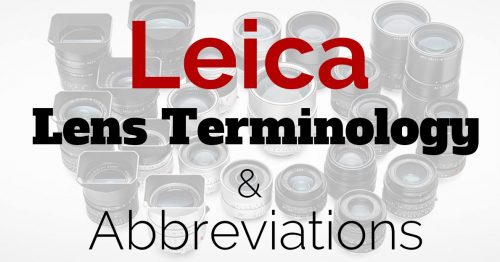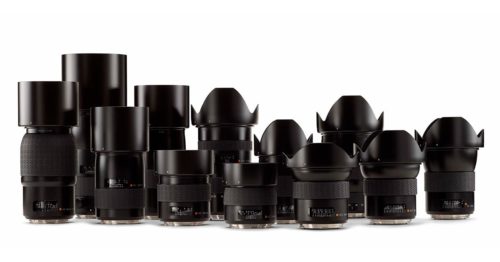Table of Contents
Nikon Lens Mounts
In this article, we will the talking about lenses from three different Nikon Lens mounts. The Z-Mount, the F-Mount and the 1-Mount.
Z-Mount
The Nikon Z-Mount is an interchangeable lens mount that was introduced in 2018 alongside a new full-frame mirrorless camera system. The Z-Mount’s short 16mm flange distance and wide 55mm mount diameter will pave the way for a totally new series of Nikkor Z lenses that can use modern manufacturing techniques and optical design to attain even sharper lenses in a smaller and lighter package.
At introduction, Nikon launched three lenses for the Z-Mount, whilst at the same time providing a roadmap of future lens releases for this new format.
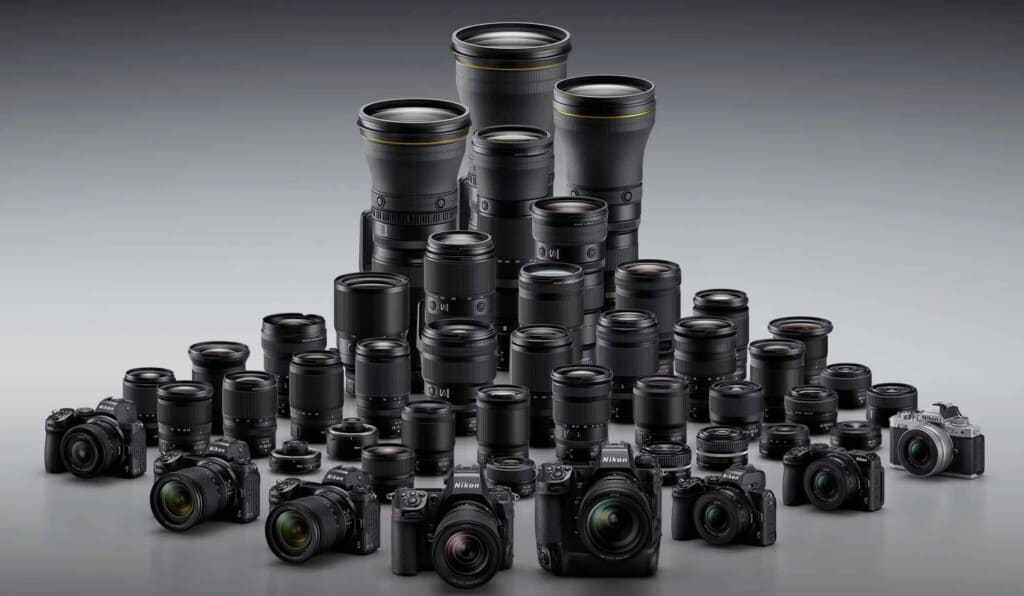
Alongside the new Nikkor Z lenses and Z-Series mirrorless camera bodies, Nikon also launched the Nikon FTZ Mount Adapter. This adapter allows you to use the vast majority of Nikkor F-Mount lenses (approximately 36o lenses) on a camera that has a Z-Mount – great news for the millions of F-Mount lens owners out there!
Full AF/AE is supported when using FX or DX AF-S Type G, D or E lenses, as well as AF-P type G and E lenses, and AF-I type D lenses. It’s also fully compatible with AF-S/AF-I Teleconverters.
Note that there is no way to go the opposite way and mount Nikkor Z lenses on an F-Mount DSLR camera. The Z-Mount is simply far too wide.
Most popular Z lenses: NIKKOR Z 35mm f/1.8 S Lens | NIKKOR Z 50mm f/1.8 S Lens | NIKKOR Z 24-70mm f/4 S Lens
F-Mount
The Nikon F-mount is Nikon’s standard DSLR lens mounting system. Introduced in 1959, F-mount lenses have been in production for over 50 years and the range currently encompasses over 400 Nikkor lenses; In the 1980s, with the coming of the auto-focus revolution Nikon, unlike other manufacturers, chose to adapt the F-mount rather than scrapping it in favour of a new auto-focus compatible lens mounting system. This decision cemented the F-mount’s unquestionable claim of being the largest interchangeable lens system ever manufactured.
The Nikon F-mount system features a high level of lens and camera compatibility; Many early manual-focus lenses can with slight modification be used on modern Nikon cameras, and many current Nikon lenses can be used on the original Nikon F SLR. It is worth noting however that some compatibility issues do exist, so be sure to check manufacturer documentation before experimenting with new combinations.
Nikon Lens Formats
Nikon FX Lenses
Nikon’s FX lenses resolve an image the size of a 35mm full-frame sensor and are designed to be used with Nikon’s full-frame camera bodies like the Z5, Z6, Z7, Z8, and Z9 series. FX lenses can be mounted on Nikon’s APS-C crop sensor DX-format bodies, but a 1.5x crop factor will apply to the field of view compared to a full-frame camera.
Unlike DX-Format lenses, where Nikon uses the DX lettering within the lens model name (e.g., Nikon Z DX 24mm f/1.7), Nikon does not use the FX moniker in the lens model name for FX lenses. Instead, the accurate assumption is that if a lens model does not have DX in the name, it is an FX lens.
Most popular FX lenses: Nikon Z 24-120mm f/4 VR S | Nikon Z 24-70mm f/2.8 S | Nikon Z 70-200 f/2.8 VR S | Nikon Z 180-600mm f/5.6-6.3 VR | Nikon Z 50mm f/1.8 S
Nikon DX Lenses
DX lenses are designed for Nikon’s APS-C crop sensor DX-Format cameras. DX lenses are generally smaller and cheaper than their FX equivalents, making them an excellent choice for amateur and enthusiast shooters who cannot justify the cost of more expensive full-frame systems.
Although intended for use on DX-Format APS-C camera bodies like the Z30 or Z50 lines or previous generation F-Mount APS-C DSLR like the D7500, DX lenses can be mounted on FX-Format bodies like the Z5, Z6, Z7, Z8, and Z9 and used in the camera’s DX Crop Mode. When mounted to an FX-Format body, the camera will automatically adjust the viewfinder and capture a cropped DX-sized image from the center of the full-frame sensor. Note that DX lenses are not compatible with Nikon 35mm film cameras.
Most popular DX lenses: Nikon Z DX 24mm f/1.7 | Nikon Z DX 18-140mm f/3.5-6.3 VR | Nikon Z DX 12-28mm f/3.5-5.6 PZ VR | Nikon Z DX 50-250mm f/4.5-6.3 VR
Nikon CX Lenses
CX-Format lenses, also known as 1 Nikkor lenses, were introduced in 2011 to be used with the Nikon 1 mirrorless system and the Nikon 1-Mount. Now discontinued, the Nikon 1 system used a tiny 13.2 x 8.8mm sensor and a much smaller lens mount than DX-Format or FX-Format F-Mount or Z-Mount cameras, called the CX-Mount.
CX lenses cannot be mounted directly on DX or FX-format camera bodies; however, the Nikon FT1 F-Mount adaptor allows using all F-mount DSLR lenses on legacy Nikon 1 camera bodies. There was also a small subsection of the CX line called CX-AW, which will be discussed later in the article.
Most popular CX lenses: 1 Nikkor 18.5mm f/1.8 | Nikon 1 NIKKOR 6.7-13mm f/3.5-5.6 VR | 1 Nikkor VR 70-300mm f/4.5-5.6 VR
Nikon Lens Types
Macro Lenses
A Macro lens features a 1:1 magnification ratio for taking highly detailed, life-sized images of subjects. Nikon began making microscopes in 1903 and made their first lens specifically designed for close-up macro photography in 1956. F-Mount DSLR macro lenses carried the Micro Nikkor branding as a nod to the company’s history.
In transitioning to the mirrorless Z-Mount, Nikon replaced the Micro Nikkor name on the lens with the letters MC. Though MC is a slightly odd way to abbreviate Micro Nikkor -MN would have made more sense- Nikon maintains that MC does stand for Micro Nikkor. Thus, their catalog still refers to MC lenses as Micro Nikkor, but not directly on the lens barrel.
Most Popular Macro Lenses: Nikon Z MC 105mm f/2.8 VR S | Nikon Z MC 50mm f/2.8
PC Lenses
Nikon’s PC or ‘Perspective Control’ lenses are the company’s equivalent of Canon’s ‘Tilt-Shift’ lenses. These manual focus lenses enable the photographer to alter the angle between the focal plane and the camera sensor. This adjustment allows compensation for the Keystone effect, which causes parallel lines in an image to converge if the camera is not perfectly level. PC lenses can also be used to increase the depth of field at wide apertures, and are extremely popular with landscape and architectural photographers.
Most popular PC lenses: Nikon PC-E 24mm f/3.5D ED | Nikon PC 19mm f/4E ED |
DC Lenses
DC or ‘Defocus Control’ lenses are designed for portrait photography and allow subtle alteration of out of focus elements or bokeh. Not to be confused with soft-focus lenses, DC lenses are in fact extremely sharp at in-focus image areas. Bokeh is adjusted by controlling the amount of spherical aberration in specific areas of an image, allowing the shooter to make subtle background adjustments that can dramatically alter an image’s impact.
There are only two DC lenses: Nikon AF FX DC-NIKKOR 105mm f/2D | Nikon AF DC-NIKKOR 135mm f/2D |
Gold Ring Lenses
Nikon’s use of a gold ring around the front of the lens has changed with the move to the mirrorless Z-Mount system. A gold ring around the front of a Nikon F-Mount DSLR lens indicated that the lens was of professional quality. For their newer Z-Mount lenses, Nikon uses the Nikkor “S Line” designation to indicate a pro-level lens. Still, several Nikkor Z lenses do feature the famed gold ring. These are the Z 600mm f/6.3, the Z 400mm f/2.8, the Z 600mm f/4, and the Z 800mm f/6.3.
While Nikon was clear that the “Gold” F-Mount lenses meant “pro,” they have been tight-lipped on the ring’s meaning to Z-Mount lenses. So far, all gold-ringed Z lenses are also “S” lenses, and they are also all lenses with a focal length of 400mm or greater. Notably, though, the Z 400mm f/4.5 VR S lacks the gold ring, so we can’t even say that the gold ring is limited to S Line prime lenses of 400mm or above. Perhaps they mean it to be an indication of the lens’ cost? Currently, the four gold-ringed Z lenses are also Nikon’s four most expensive Z lenses, so this theory has some credence.
Most popular Gold Ring lenses: Nikon Z 600mm f/6.3 VR S | Nikon Z 800mm f/6.3 VR S | Nikon Z 600mm f/4 TC VR S | Nikon Z 400mm f/2.8 TC VR S
Nikon Lens Abbreviations & Acronyms
AW
As part of the 1 Nikon camera lineup, Nikon released some full waterproof cameras that used the CX mount described at the beginning of the article in the mounts section. Along with these cameras came several fully waterproof lenses which carry the AW designation for All Weather. When mounted on a waterproof 1 Nikon camera, you can submerge the pair completely in water.
Most popular AW lenses: Nikon 1 AW 11-27.5mm f/3.5-5.6 | Nikon 1 Nikkor AW 10mm f/2.8 |
AF
Autofocus lenses are denoted by the acronym ‘AF’ older AF lenses used a physical connection between the camera body (where the motor was housed) and lens to focus on a subject. Newer AF-S lenses feature a ‘Silent Wave’ motor built into the lens barrel. The only lenses in the current Nikkor lineup that are not AS lenses are the PC and PC-E lenses. Due to the physical rotation and movements of the lens body, it’s simply not possible to include a focus racking system. The same goes for other tilt-shift style lenses from other manufacturers.
AF-D
Autofocus lenses that pass distance information to the camera body. Since all modern Nikkor lenses now pass this information to the camera, the designation is no longer used. Technically all current Nikkors are therefore AF-D. This is another of those situations where designation was far more important when the technology first came out, and the lens lineup featured some lenses that did not have this ability. NOTE: Some AF-D lenses simply featured the D designation directly after the max aperture value e.g. NIKKOR 50mm f/1.8D
Most popular AF-D lenses: Nikon AF NIKKOR 50mm f/1.8D | Nikon AF Zoom-NIKKOR 80-200mm f/2.8D ED
AF-P
Introduced at the beginning of 2016, the AF-P lenses feature a “stepping motor” like Canon’s STM lenses. This style of motor is much is considerably quieter than AF-S technology, and it also has a much smoother motion during the focus process. AF-P is therefore ideal for shooting video, to both maintain a smooth motion during zooming, and also so that you don’t hear the focus motors in the recording.
Most popular AF-P lenses: Nikon AF-P DX 18-55mm f/3.5-5.6G VR | Nikon AF-P DX 70-300mm f/4.5-6.3G ED VR
AF-S/SWM
Autofocus lenses with built-in ‘Silent Wave’ Motors which convert travelling waves into rotational energy to focus the lens optics. Designed to be used on bodies with no built-in motor, AF-S lenses are fast, accurate, and quiet and all but the cheapest feature full-time manual focus override. Almost every current Nikkor lens now features the AF-S designation, but there are some that use AF-P, see next entry.
ASP/AS
ASP and AS lenses contain at least one Aspherical lens element. The profile of an aspherical element does not conform to the surface of a sphere. Aspherical elements are used to correct coma and various other types of lens aberrations but are costly and complex to manufacture. Aspherical elements first began to appear in Nikon lenses in 1968 and some older lenses feature this designation externally. Modern-day lenses may feature the AS designation within the lens specifications, but it is not written externally on the lens anymore.
ASED
Lenses feature ASP Aspherical elements made of ED glass.
CRC
‘Close-Range Correction’ system lenses allow excellent image quality to be captured at close focusing distances. Lens groups move independently during focusing to maintain optical performance in close focus situations by using a floating element lens design. Nikon used the CRC system is used in fisheye lenses, wide-angle lenses, Micro macro lenses, and a few medium telephoto lenses starting in 1967. The designation is no longer found on modern lenses because elements of this design philosophy are now present in all lenses, but CRC can still be found on some older second-hand lenses like the Nikkor 35mm f/1.4 AI-s.
Most popular CRC lenses: Nikkor 35mm f/1.4 AI-s | Nikkor 28mm f/2.8 AI-s
E
E-type lenses feature electronic diaphragm control, severing the physical connection between aperture lever and camera of older lenses in favour of a completely electronic system. E-Type lenses provide faster, more accurate aperture actuation allowing higher frame-rates when shooting in shutter priority modes. The system is more expensive than D and G lens aperture mechanisms, so is only available at the moment in Nikon’s high-end professional lenses.
Most popular E lenses: Nikon AF-S 400mm f/2.8E FL ED VR | Nikon AF-S 24-70mm f/2.8E ED VR | Nikon AF-S 105mm f/1.4E ED
ED
ED indicates that a lens uses ‘Extra-low Dispersion’ glass, a technology developed by Nikon to allow the production of lenses that significantly reduce chromatic aberration. Previously chromatic aberration was reduced by using calcium fluorite-based glass, but it’s brittle nature and temperature sensitivity led Nikon to develop ED as a more robust solution.
Most Popular ED Lenses: Nikon AF-S 300mm f/4E PF ED VR | Nikon AF-S 24-70mm f/2.8E ED VR
FL
FL lenses feature elements manufactured from Fluorite, a monocrystal optical material. Fluorite is excellent at correcting chromatic aberration within the visible light spectrum and is lighter than optical glass, helping to improve lens weight, balance, and handling with super-telephoto focal lengths.
Nikon included the FL acronym in the lens model name of F-Mount telephoto lenses that included this feature. Interestingly, Flourite elements were not used in the optical design of Nikon’s Z-Mount super-telephoto lenses.
Most popular FL lenses: Nikon AF-S FX 500mm f/4E FL ED VR | Nikon AF-S 400mm f/2.8E FL ED VR
G
G-type Nikkor lenses are F-Mount DSLR lenses with no physical aperture ring. The aperture of the lens can only be altered through the camera body. G-type lenses can be mounted onto manual focus bodies, but the photographer cannot change the lens aperture. In the final years of the F-Mount DSLR lenses, all new Nikkors were G-type lenses.
In the DSLR F-Mount days, some Nikon lenses had aperture rings, and some did not, resulting in a need to differentiate. With the move to the mirrorless Z-Mount, Nikon stopped using the G label in their lens names since there are no Z lenses with aperture rings.
Most popular G lenses: Nikon 85mm f/1.8G | Nikon DX 35mm f/1.8G | Nikon 50mm f/1.8G
IF
IF or ‘Internal focusing’ allows the lens to focus without altering its physical size. Elements within the lens barrel move to acquire focus, allowing for lighter, more compact lens designs and faster focus speeds. Nikon largely used the IF designation in the model name of F-Mount DSLR lenses at a time when designing internally focussing lenses was more challenging and less common.
Most modern Z-Mount mirrorless lenses are internally focused but lack the IF designation directly in the model name. If a lens does focus internally, though, Nikon still includes the IF designation in a list of the lens features on its website.
Most popular IF lenses: Nikon AF-S VR Micro-NIKKOR 105mm f/2.8G IF-ED | Nikon AF-S VR Zoom-NIKKOR 70-300mm f/4.5-5.6G IF-ED
N
The letter N on a Nikon F-Mount DSLR lens indicates the lens includes Nikon’s Nano Crystal Coating technology. N lens elements are coated in nano-sized crystallized particles, dramatically reducing inter-element reflection within a lens and helping reduce ghosting and flare, which can be problematic in wide-angle lenses.
While Nikon used the N badge for Nano Crystal Coated F-Mount lenses, they discontinued this practice on newer Z-Mount mirrorless lenses. Many of Nikon’s Z-Mount S Line lenses still feature Nano Crystal Coated elements, but none flaunt the fact on the lens barrel. To see if a Z-Mount lens features Nano Crystal Coatings, refer to the product’s specifications.
Most popular N lenses: Nikon 70-200mm f/2.8E FL ED VR Lens | Nikon AF-S 24-70mm f/2.8E ED VR | Nikon AF-S 14-24mm f/2.8
Noct
The Noct lens designation is reserved for lenses with an aperture of f/1.2 or less. The first Nikkor Z Noct lens is the Nikon 58mm f/0.95 S Noct, released in 2019. The lens is manual focus only, has an LCD screen on the top to display focus and depth of field information, and features an eye-watering $8000 price point. The original Nikon Noct lens was the Noct-Nikkor 58mm f/1.2 lens produced from 1977 to 1997.
Most popular Noct lens: Nikon Z 58mm f/0.95 S Noct |
PC-E
PC-E lenses are the same Perspective Control lenses discussed in the earlier lens type section.
Most popular PC-E lenses: Nikon PC-E 24mm f/3.5D ED | Nikon PC-E Micro-NIKKOR 45mm f/2.8D ED | Nikon PC-E Micro-NIKKOR 85mm f/2.8D |
PF

PF stands for Phase Fresnel. Nikon’s Phase Fresnel lenses are equivalent to Canon’s DO (Diffractive Optics) lenses. PF lenses use a specially designed diffractive lens element to correct chromatic aberration, whereas a typical refractive lens requires several elements to achieve the same thing. The diffractive element features a microscopically grooved rear element that forces light of different wavelengths to converge on the same point. The result of using a single element for these corrections is a much smaller and lighter lens than possible without phase fresnel elements.
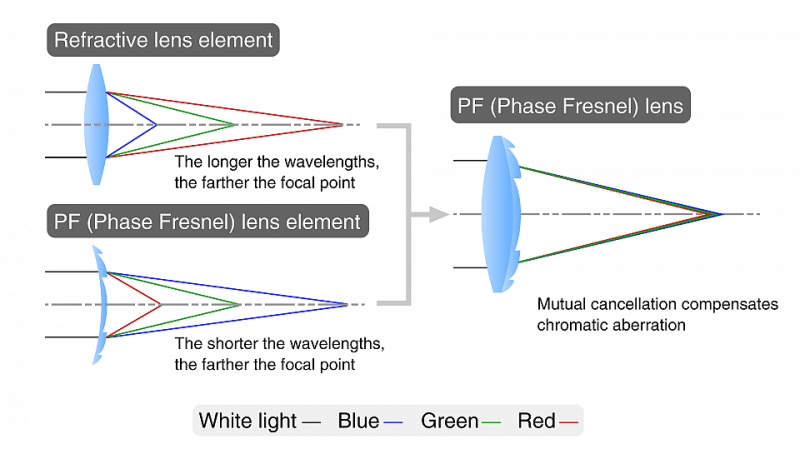
The Nikon PF line began in 2015 with the NIKKOR 300mm f/4E PF ED VR, followed by the NIKKOR 500mm f/5.6E PF ED VR in 2018. In 2022, Nikon launched the first lens for the Nikon Z-Mount system to use PF lens elements, the NIKKOR Z 800mm f/6.3 VR S. This was followed in 2023 by the launch of the Z 600mm f/6.3 VR S. While Nikon no longer uses the PF acronym in the model name of these new Z Mount prime lenses, both rely heavily on PF technology for their incredibly compact and lightweight designs.
Most popular PF lenses: NIKKOR Z 800mm f/6.3 VR S | NIKKOR Z 600mm f/6.3 VR S
PZ

PZ in a Nikon lens model name stands for Power Zoom. The first Nikon Power Zoom lens, the Nikon Z DX 12-28mm f/3.5-5.6 PZ, was introduced in 2023, followed by the Nikon Z 28-135mm f/4 PZ in 2025. PZ lenses are “zoom by wire” lenses. This means the zoom ring electronically actuates a linear zoom motor rather than acting mechanically on the zoom mechanism.
Useful for video recording, Power Zoom lenses can be smoothly zoomed at varying rates using the magnification buttons on select Nikon Z cameras, the Nikon ML-L7 Bluetooth remote, the SnapBridge mobile app, when using NX Tether Software, using the assignable lens control ring, the optional MC-N10 Remote Grip, and, in some cases like the Z 28-135mm, by using a zoom rocker switch on the side of the lens. The Power Zoom feature delivers consistent and repeatable zooming speeds and silent and precise results for continuity between takes.
Most popular PZ lenses: Nikon Z DX 12-28mm f/3.5-5.6 PZ | Nikon Z 28-135mm f/4 PZ
VR
Lenses featuring built-in vibration reduction are designated with the letter VR in the lens model name. Lenses with VR are helpful for hand-held shooting in low-light situations or locations that do not allow a tripod to be used. Vibration Reduction works using a system of sensors that measure angular velocity from camera shake. This data is then translated into an opposite motion of lens elements, moved by voice coil motors, to counteract the shake.
Most popular VR lenses: Nikon Z 70-200mm f/2.8 VR S | Nikon Z 100-400mm f/4.5-5.6 VR S | Nikon Z 180-600mm f/4.5-5.6 VR | Nikon Z 600mm f/6.3 VR S
RF
Only the rear lens element moves during focusing in RF or ‘Rear Focusing’ lenses. Like IF Internal Focus lenses, this allows the lens to focus without changing physical size, allowing for compact lens designs and faster autofocus performance. The RF designation is not used externally on any modern Nikkor lenses but can be found in feature lists of some Nikon F-Mount DSLR lenses, like the AF-S NIKKOR 24mm f/1.4G ED.
As far as I’m aware, Nikon has not designated any Z-Mount mirrorless lenses as RF lenses, possibly because the larger Z-Mount and shorter flange distance no longer benefit this lens design method.
SIC
Nikon’s SIC or Super Integrated Coating is an exclusive multi-layer lens coating process that reduces ghosting and flare dramatically. SIC lenses also show superior color balance and reproduction. The SIC acronym is not marked externally on the lens barrel or included in the lens model name, but it is listed in a list of lens features in the Nikon lens catalog. Most of Nikon’s Z-Mount S Line wide-angle and standard focal length zooms and prime lenses feature SIC coating.
Popular SIC lenses: Nikon Z 24mm f/1.8 S | Nikon 14-24mm f/2.8 S | Nikon 14-30mm f/4 S | Nikon Z 20mm f/1.8 S | Nikon Z 24-200mm f/4-6.3 VR | NIkon Z 24-70mm f/2.8 S
Plena

The first Nikon Plena lens was the Nikon Z 135mm f/1.8 S Plena, launched in 2023. The 135mm Plena delivers exceptionally smooth bokeh and stunning sharpness, making it the ultimate portrait lens. Nikon explains that “the Latin origin of Plena means full to the brim, almost overflowing — evoking the creative fulfillment that the groundbreaking optics of this lens offer for the first time.”
Most popular Plena lens: Nikon Z 135mm f/1.8 S Plena
S-Line
The silver “S” branded on the side of some Nikon Z-Mount lenses and included in the lens model name indicates that the lenses are part of Nikon’s highest-grade S Line. Nikon says S Line lenses were “developed in pursuit of a higher level of optical performance.” In essence, Nikon’s S Line lenses are equivalent to Sony’s GM and Canon’s L Series lenses.
Among older F-Mount DSLR lenses, Nikon used a gold ring to indicate their highest quality, best-performing lenses. With the move to the mirrorless Z-Mount, Nikon intends the S Line branding to indicate the same pro-level quality and, consequently, high pricing.
Most popular S-Line lenses: Nikon Z 70-200mm f/2.8 VR S | Nikon Z 50mm f/1.2 S | Nikon Z 50mm f/1.8 S | Nikon Z 24-70mm f/2.8 S | Nikon Z 135mm f/1.8 S Plena | Nikon Z 35mm f/1.2 S
TC
TC stands for teleconverter, and any lens with TC in the official name has a built-in 1.4x teleconverter that can be engaged with the flick of a switch. The first Nikon TC lens was the F-Mount Nikon 180-400mm f/4E TC1.4 FL ED VR. This was followed by the Z-Mount Nikon 400mm f/2.8 TC VR S and the Nikon 600mm f/4 TC VR S.
The teleconverter built into the lens is a huge timesaver and a popular option for sports and wildlife photographers. Not having to remove the lens from the camera to add a teleconverter is also a benefit for those working in dusty or sandy environments.
Most popular TC lenses: NIKKOR Z 400mm f/2.8 TC VR S | NIKKOR 600mm f/4 TC VR S |
Pin This Post
